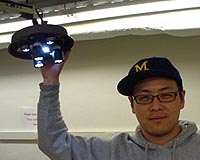 |
Cambridge MA (SPX) May 13, 2009 MIT engineers and colleagues have built a new tissue scaffold that can stimulate bone and cartilage growth when transplanted into the knees and other joints. The scaffold could offer a potential new treatment for sports injuries and other cartilage damage, such as arthritis, says Lorna Gibson, the Matoula S. Salapatas Professor of Materials Science and Engineering and co-leader of the research team with Professor William Bonfield of Cambridge University. "If someone had a damaged region in the cartilage, you could remove the cartilage and the bone below it and put our scaffold in the hole," said Gibson. The researchers describe their scaffold in a recent series of articles in the Journal of Biomedical Materials Research. The technology has been licensed to Orthomimetics, a British company launched by one of Gibson's collaborators, Andrew Lynn of Cambridge University. The company recently started clinical trials in Europe. The scaffold has two layers, one that mimics bone and one that mimics cartilage. When implanted into a joint, the scaffold can stimulate mesenchymal stem cells in the bone marrow to produce new bone and cartilage. The technology is currently limited to small defects, using scaffolds roughly 8 mm in diameter. The researchers demonstrated the scaffold's effectiveness in a 16-week study involving goats. In that study, the scaffold successfully stimulated bone and cartilage growth after being implanted in the goats' knees. The project, a collaboration enabled by the Cambridge-MIT Institute, began when the team decided to build a scaffold for bone growth. They started with an existing method to produce a skin scaffold, made of collagen (from bovine tendon) and glycosaminoglycan, a long polysaccharide chain. To mimic the structure of bone, they developed a technique to mineralize the collagen scaffold by adding sources of calcium and phosphate. Once that was done, the team decided to try to create a two-layer scaffold to regenerate both bone and cartilage (known as an osteochondral scaffold). Their method produces two layers with a gradual transition between the bone and cartilage layers. "We tried to design it so it's similar to the transition in the body. That's one of the unique things about it," said Gibson. There are currently a few different ways to treat cartilage injuries, including stimulating the bone marrow to release stem cells by drilling a hole through the cartilage into the bone; transplanting cartilage and the underlying bone from another, less highly loaded part of the joint; or removing cartilage cells from the body, stimulating them to grow in the lab and re-implanting them. The new scaffold could offer a more effective, less expensive, easier and less painful substitute for those therapies, said Gibson. Share This Article With Planet Earth
Related Links Massachusetts Institute of Technology Hospital and Medical News at InternDaily.com
 Students Design Low-Cost Surgical Lamp For Developing Nations
Students Design Low-Cost Surgical Lamp For Developing NationsAnn Arbor MI (SPX) May 08, 2009 Engineering students have developed a low-cost, battery-powered surgical lamp to be used in developing nations where electricity isn't reliable. Earlier this month, members of Michigan Health Engineered for All Lives, or M-HEAL, sent their prototype lamp to Uganda where it will undergo testing. "The power grid is very unreliable in developing countries," said Stephen DeWitt, co-found ... read more |
|
| The content herein, unless otherwise known to be public domain, are Copyright 1995-2009 - SpaceDaily. AFP and UPI Wire Stories are copyright Agence France-Presse and United Press International. ESA Portal Reports are copyright European Space Agency. All NASA sourced material is public domain. Additional copyrights may apply in whole or part to other bona fide parties. Advertising does not imply endorsement,agreement or approval of any opinions, statements or information provided by SpaceDaily on any Web page published or hosted by SpaceDaily. Privacy Statement |